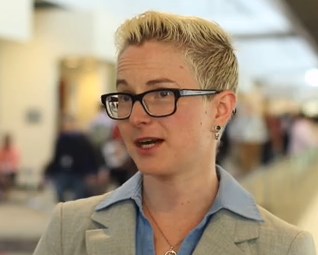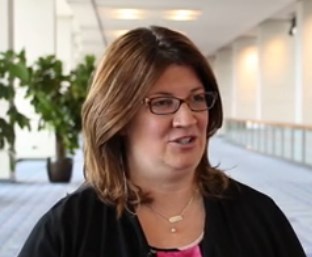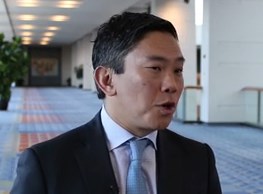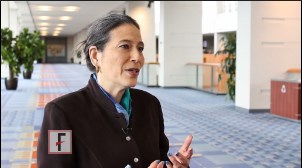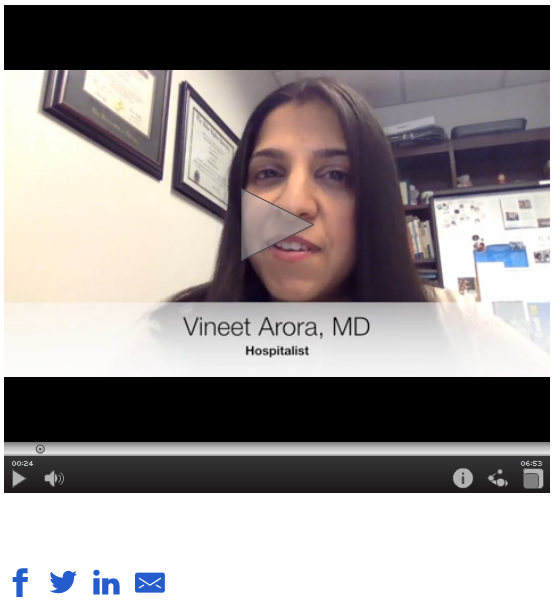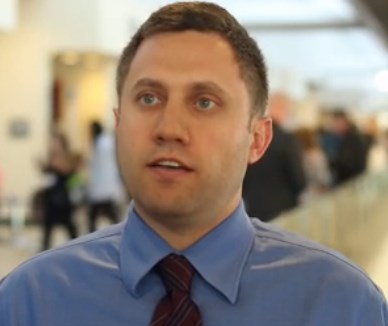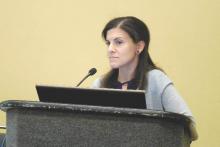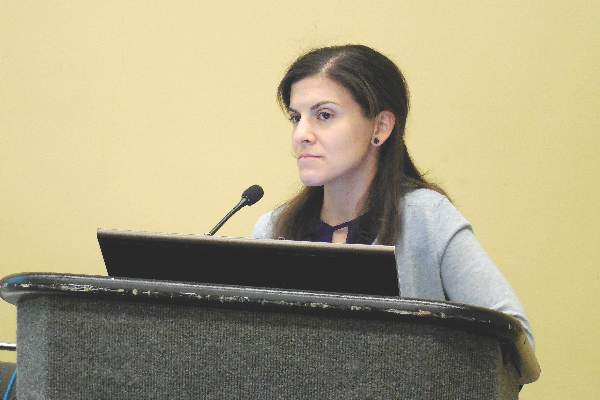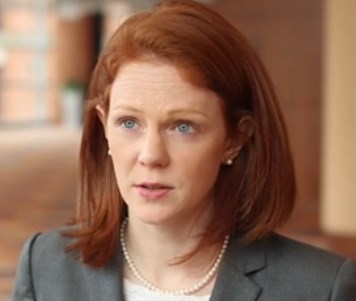User login
VIDEO: Caring for transgender youth will require care across specialties
BALTIMORE – Training in transgender care needs to be amplified across all specialties, including pediatrics, as the number of transgender individuals, both young and old, continues to climb.
“We all have a gender, we all have a gender identity, we all have a way in which we express that to the world around us, and to ignore that part of a human being [and] a patient would be a real detriment [to] our society,” explained Dr. Kristen Eckstrand a resident in the child psychiatry program at the University of Pittsburgh.
In an interview at the annual meeting of the Pediatric Academic Societies, Dr. Eckstrand discussed strategies for talking to transgender patients to provide the best care for them, and the importance of working across professions and specialties when the situation calls for it.
Dr. Eckstrand did not report any relevant financial disclosures.
The video associated with this article is no longer available on this site. Please view all of our videos on the MDedge YouTube channel
Go to LGBT Youth Consult on our site for articles on the nature of sexuality and gender identity and how they affect health, advice on how to talk with your patients about these topics, and how to make your office a safe place for LGBT youth.
BALTIMORE – Training in transgender care needs to be amplified across all specialties, including pediatrics, as the number of transgender individuals, both young and old, continues to climb.
“We all have a gender, we all have a gender identity, we all have a way in which we express that to the world around us, and to ignore that part of a human being [and] a patient would be a real detriment [to] our society,” explained Dr. Kristen Eckstrand a resident in the child psychiatry program at the University of Pittsburgh.
In an interview at the annual meeting of the Pediatric Academic Societies, Dr. Eckstrand discussed strategies for talking to transgender patients to provide the best care for them, and the importance of working across professions and specialties when the situation calls for it.
Dr. Eckstrand did not report any relevant financial disclosures.
The video associated with this article is no longer available on this site. Please view all of our videos on the MDedge YouTube channel
Go to LGBT Youth Consult on our site for articles on the nature of sexuality and gender identity and how they affect health, advice on how to talk with your patients about these topics, and how to make your office a safe place for LGBT youth.
BALTIMORE – Training in transgender care needs to be amplified across all specialties, including pediatrics, as the number of transgender individuals, both young and old, continues to climb.
“We all have a gender, we all have a gender identity, we all have a way in which we express that to the world around us, and to ignore that part of a human being [and] a patient would be a real detriment [to] our society,” explained Dr. Kristen Eckstrand a resident in the child psychiatry program at the University of Pittsburgh.
In an interview at the annual meeting of the Pediatric Academic Societies, Dr. Eckstrand discussed strategies for talking to transgender patients to provide the best care for them, and the importance of working across professions and specialties when the situation calls for it.
Dr. Eckstrand did not report any relevant financial disclosures.
The video associated with this article is no longer available on this site. Please view all of our videos on the MDedge YouTube channel
Go to LGBT Youth Consult on our site for articles on the nature of sexuality and gender identity and how they affect health, advice on how to talk with your patients about these topics, and how to make your office a safe place for LGBT youth.
AT THE PAS ANNUAL MEETING
VIDEO: Is hysterectomy still best for complex atypical hyperplasia?
WASHINGTON – Hysterectomy has long been the first-line therapy for complex atypical endometrial hyperplasia in patients who don’t desire to preserve their fertility. Is it time to consider hormone treatment in a larger population of patients?
That’s the question that experts debated at the annual meeting of the American College of Obstetricians and Gynecologists.
Dr. Amanda Nickles Fader, associate professor and director of the Kelly Gynecologic Oncology Service* at the Johns Hopkins Hospital, Baltimore, said in an interview that changing patient demographics – particularly the growing number of overweight and obese women – are driving the need to consider the use of progestin in more cases. The obesity epidemic translates into younger women developing the condition, and it creates the potential for more complications in surgery, she said. Endometrial hyperplasia is very sensitive to hormone therapy, specifically progestin agents, with 75%-90% response rates with up-front treatment, Dr. Fader added.
But Dr. David Cohn, director of the division of gynecologic oncology at the Ohio State University, Columbus, said in an interview that surgery remains the standard of care because it is curative. Hormone treatment is appropriate in selected patients, but it is currently understudied and questions remain about the duration of treatment and about the type of hormones to use, he said.
Dr. Cohn and Dr. Fader both reported having no relevant financial disclosures.
The video associated with this article is no longer available on this site. Please view all of our videos on the MDedge YouTube channel
The video associated with this article is no longer available on this site. Please view all of our videos on the MDedge YouTube channel
mschneider@frontlinemedcom.com
On Twitter @maryellenny
*Correction, 5/17/2016: An earlier version of this story misstated Dr. Fader's title.
WASHINGTON – Hysterectomy has long been the first-line therapy for complex atypical endometrial hyperplasia in patients who don’t desire to preserve their fertility. Is it time to consider hormone treatment in a larger population of patients?
That’s the question that experts debated at the annual meeting of the American College of Obstetricians and Gynecologists.
Dr. Amanda Nickles Fader, associate professor and director of the Kelly Gynecologic Oncology Service* at the Johns Hopkins Hospital, Baltimore, said in an interview that changing patient demographics – particularly the growing number of overweight and obese women – are driving the need to consider the use of progestin in more cases. The obesity epidemic translates into younger women developing the condition, and it creates the potential for more complications in surgery, she said. Endometrial hyperplasia is very sensitive to hormone therapy, specifically progestin agents, with 75%-90% response rates with up-front treatment, Dr. Fader added.
But Dr. David Cohn, director of the division of gynecologic oncology at the Ohio State University, Columbus, said in an interview that surgery remains the standard of care because it is curative. Hormone treatment is appropriate in selected patients, but it is currently understudied and questions remain about the duration of treatment and about the type of hormones to use, he said.
Dr. Cohn and Dr. Fader both reported having no relevant financial disclosures.
The video associated with this article is no longer available on this site. Please view all of our videos on the MDedge YouTube channel
The video associated with this article is no longer available on this site. Please view all of our videos on the MDedge YouTube channel
mschneider@frontlinemedcom.com
On Twitter @maryellenny
*Correction, 5/17/2016: An earlier version of this story misstated Dr. Fader's title.
WASHINGTON – Hysterectomy has long been the first-line therapy for complex atypical endometrial hyperplasia in patients who don’t desire to preserve their fertility. Is it time to consider hormone treatment in a larger population of patients?
That’s the question that experts debated at the annual meeting of the American College of Obstetricians and Gynecologists.
Dr. Amanda Nickles Fader, associate professor and director of the Kelly Gynecologic Oncology Service* at the Johns Hopkins Hospital, Baltimore, said in an interview that changing patient demographics – particularly the growing number of overweight and obese women – are driving the need to consider the use of progestin in more cases. The obesity epidemic translates into younger women developing the condition, and it creates the potential for more complications in surgery, she said. Endometrial hyperplasia is very sensitive to hormone therapy, specifically progestin agents, with 75%-90% response rates with up-front treatment, Dr. Fader added.
But Dr. David Cohn, director of the division of gynecologic oncology at the Ohio State University, Columbus, said in an interview that surgery remains the standard of care because it is curative. Hormone treatment is appropriate in selected patients, but it is currently understudied and questions remain about the duration of treatment and about the type of hormones to use, he said.
Dr. Cohn and Dr. Fader both reported having no relevant financial disclosures.
The video associated with this article is no longer available on this site. Please view all of our videos on the MDedge YouTube channel
The video associated with this article is no longer available on this site. Please view all of our videos on the MDedge YouTube channel
mschneider@frontlinemedcom.com
On Twitter @maryellenny
*Correction, 5/17/2016: An earlier version of this story misstated Dr. Fader's title.
EXPERT ANALYSIS FROM ACOG 2016
VIDEO: Should the HPV test be a stand-alone cancer screening test?
WASHINGTON – Despite being approved by the Food and Drug Administration as a primary cervical cancer screening test starting at age 25, most medical societies recommend that the human papillomavirus (HPV) test be used as part of a cotesting strategy with cytology, and only among women age 30 years and older.
At the annual meeting of the American College of Obstetricians and Gynecologists, physicians debated whether the HPV test was ready to replace the pap smear as the standard primary screening test for cervical cancer.
Dr. Warner K. Huh, professor and director of gynecologic oncology at the University of Alabama at Birmingham, said in a video interview that the HPV test has already clearly been shown to be superior to cytology, which has a low sensitivity and is highly subjective. There also is a minimal difference between the sensitivity of HPV testing alone versus the combination of the HPV test and cytology, he added.
Although most physicians may not yet be ready to use the HPV test alone, Dr. Huh said that he sees the medical community gradually moving in that direction.
But Dr. George Sawaya, professor in obstetrics, gynecology, and reproductive sciences and epidemiology and biostatistics at the University of California, San Francisco, said in a video interview that he’s concerned that the use of the HPV test alone will result in women undergoing further testing – including cytology and colposcopy – and long-term monitoring. He added that any type of screening is valuable and that the key to decreasing cervical cancer cases and deaths is to reach those women who have never been screened.
The video associated with this article is no longer available on this site. Please view all of our videos on the MDedge YouTube channel
The video associated with this article is no longer available on this site. Please view all of our videos on the MDedge YouTube channel
mschneider@frontlinemedcom.com
On Twitter @maryellenny
WASHINGTON – Despite being approved by the Food and Drug Administration as a primary cervical cancer screening test starting at age 25, most medical societies recommend that the human papillomavirus (HPV) test be used as part of a cotesting strategy with cytology, and only among women age 30 years and older.
At the annual meeting of the American College of Obstetricians and Gynecologists, physicians debated whether the HPV test was ready to replace the pap smear as the standard primary screening test for cervical cancer.
Dr. Warner K. Huh, professor and director of gynecologic oncology at the University of Alabama at Birmingham, said in a video interview that the HPV test has already clearly been shown to be superior to cytology, which has a low sensitivity and is highly subjective. There also is a minimal difference between the sensitivity of HPV testing alone versus the combination of the HPV test and cytology, he added.
Although most physicians may not yet be ready to use the HPV test alone, Dr. Huh said that he sees the medical community gradually moving in that direction.
But Dr. George Sawaya, professor in obstetrics, gynecology, and reproductive sciences and epidemiology and biostatistics at the University of California, San Francisco, said in a video interview that he’s concerned that the use of the HPV test alone will result in women undergoing further testing – including cytology and colposcopy – and long-term monitoring. He added that any type of screening is valuable and that the key to decreasing cervical cancer cases and deaths is to reach those women who have never been screened.
The video associated with this article is no longer available on this site. Please view all of our videos on the MDedge YouTube channel
The video associated with this article is no longer available on this site. Please view all of our videos on the MDedge YouTube channel
mschneider@frontlinemedcom.com
On Twitter @maryellenny
WASHINGTON – Despite being approved by the Food and Drug Administration as a primary cervical cancer screening test starting at age 25, most medical societies recommend that the human papillomavirus (HPV) test be used as part of a cotesting strategy with cytology, and only among women age 30 years and older.
At the annual meeting of the American College of Obstetricians and Gynecologists, physicians debated whether the HPV test was ready to replace the pap smear as the standard primary screening test for cervical cancer.
Dr. Warner K. Huh, professor and director of gynecologic oncology at the University of Alabama at Birmingham, said in a video interview that the HPV test has already clearly been shown to be superior to cytology, which has a low sensitivity and is highly subjective. There also is a minimal difference between the sensitivity of HPV testing alone versus the combination of the HPV test and cytology, he added.
Although most physicians may not yet be ready to use the HPV test alone, Dr. Huh said that he sees the medical community gradually moving in that direction.
But Dr. George Sawaya, professor in obstetrics, gynecology, and reproductive sciences and epidemiology and biostatistics at the University of California, San Francisco, said in a video interview that he’s concerned that the use of the HPV test alone will result in women undergoing further testing – including cytology and colposcopy – and long-term monitoring. He added that any type of screening is valuable and that the key to decreasing cervical cancer cases and deaths is to reach those women who have never been screened.
The video associated with this article is no longer available on this site. Please view all of our videos on the MDedge YouTube channel
The video associated with this article is no longer available on this site. Please view all of our videos on the MDedge YouTube channel
mschneider@frontlinemedcom.com
On Twitter @maryellenny
EXPERT ANALYSIS FROM ACOG 2016
VIDEO: What’s the role for flibanserin in sex dysfunction treatment?
WASHINGTON – Since the August 2015 approval of flibanserin for the treatment of hypoactive sexual desire disorder in premenopausal women, the drug has been under a cloud of controversy.
At the annual meeting of the American College of Obstetricians and Gynecologists, physicians debated the merits of flibanserin as a treatment option and whether the condition of hypoactive sexual desire disorder has been needlessly medicalized.
Dr. Holly L. Thacker, director of the Center for Specialized Women’s Health at the Cleveland Clinic, is supportive of the Food and Drug Administration’s approval of the drug and prescribes it in her own practice. She said it’s not effective for all women in treating low sexual desire. However, for women who do respond to the drug, it makes a significant difference in their quality of life, she said.
Side effects, which include syncope, have been overstated, Dr. Thacker added. “It’s very similar, if not lower in side effects, than other [central nervous system] drugs,” she said in a video interview.
But Dr. Adriane Fugh-Berman, an associate professor at Georgetown University in Washington, said in an interview that while low libido is a real and distressing problem for women and their partners, flibanserin is not a good treatment option, adding that its greatest effect is as a sedative. She said low libido is frequently a side effect of taking other medications, such as antidepressants, or results from stress, relationship problems, or boredom. Pyschosexual counseling and medication adjustment is often a better alternative, she said.
Dr. Fugh-Berman, who is also the director of PharmedOut, a research and education project on the effect of pharmaceutical marketing on prescribing practices, said the FDA’s approval of flibanserin was largely a result of an effective marketing campaign that emphasized the need for equity in treatments for sexual health between men and women. She disclosed that she is a paid expert witness in cases involving pharmaceutical marketing practices.
The video associated with this article is no longer available on this site. Please view all of our videos on the MDedge YouTube channel
The video associated with this article is no longer available on this site. Please view all of our videos on the MDedge YouTube channel
mschneider@frontlinemedcom.com
On Twitter @maryellenny
WASHINGTON – Since the August 2015 approval of flibanserin for the treatment of hypoactive sexual desire disorder in premenopausal women, the drug has been under a cloud of controversy.
At the annual meeting of the American College of Obstetricians and Gynecologists, physicians debated the merits of flibanserin as a treatment option and whether the condition of hypoactive sexual desire disorder has been needlessly medicalized.
Dr. Holly L. Thacker, director of the Center for Specialized Women’s Health at the Cleveland Clinic, is supportive of the Food and Drug Administration’s approval of the drug and prescribes it in her own practice. She said it’s not effective for all women in treating low sexual desire. However, for women who do respond to the drug, it makes a significant difference in their quality of life, she said.
Side effects, which include syncope, have been overstated, Dr. Thacker added. “It’s very similar, if not lower in side effects, than other [central nervous system] drugs,” she said in a video interview.
But Dr. Adriane Fugh-Berman, an associate professor at Georgetown University in Washington, said in an interview that while low libido is a real and distressing problem for women and their partners, flibanserin is not a good treatment option, adding that its greatest effect is as a sedative. She said low libido is frequently a side effect of taking other medications, such as antidepressants, or results from stress, relationship problems, or boredom. Pyschosexual counseling and medication adjustment is often a better alternative, she said.
Dr. Fugh-Berman, who is also the director of PharmedOut, a research and education project on the effect of pharmaceutical marketing on prescribing practices, said the FDA’s approval of flibanserin was largely a result of an effective marketing campaign that emphasized the need for equity in treatments for sexual health between men and women. She disclosed that she is a paid expert witness in cases involving pharmaceutical marketing practices.
The video associated with this article is no longer available on this site. Please view all of our videos on the MDedge YouTube channel
The video associated with this article is no longer available on this site. Please view all of our videos on the MDedge YouTube channel
mschneider@frontlinemedcom.com
On Twitter @maryellenny
WASHINGTON – Since the August 2015 approval of flibanserin for the treatment of hypoactive sexual desire disorder in premenopausal women, the drug has been under a cloud of controversy.
At the annual meeting of the American College of Obstetricians and Gynecologists, physicians debated the merits of flibanserin as a treatment option and whether the condition of hypoactive sexual desire disorder has been needlessly medicalized.
Dr. Holly L. Thacker, director of the Center for Specialized Women’s Health at the Cleveland Clinic, is supportive of the Food and Drug Administration’s approval of the drug and prescribes it in her own practice. She said it’s not effective for all women in treating low sexual desire. However, for women who do respond to the drug, it makes a significant difference in their quality of life, she said.
Side effects, which include syncope, have been overstated, Dr. Thacker added. “It’s very similar, if not lower in side effects, than other [central nervous system] drugs,” she said in a video interview.
But Dr. Adriane Fugh-Berman, an associate professor at Georgetown University in Washington, said in an interview that while low libido is a real and distressing problem for women and their partners, flibanserin is not a good treatment option, adding that its greatest effect is as a sedative. She said low libido is frequently a side effect of taking other medications, such as antidepressants, or results from stress, relationship problems, or boredom. Pyschosexual counseling and medication adjustment is often a better alternative, she said.
Dr. Fugh-Berman, who is also the director of PharmedOut, a research and education project on the effect of pharmaceutical marketing on prescribing practices, said the FDA’s approval of flibanserin was largely a result of an effective marketing campaign that emphasized the need for equity in treatments for sexual health between men and women. She disclosed that she is a paid expert witness in cases involving pharmaceutical marketing practices.
The video associated with this article is no longer available on this site. Please view all of our videos on the MDedge YouTube channel
The video associated with this article is no longer available on this site. Please view all of our videos on the MDedge YouTube channel
mschneider@frontlinemedcom.com
On Twitter @maryellenny
EXPERT ANALYSIS FROM ACOG 2016
WATCH: Mentoring in Hospital Medicine
Drs. Vineet Arora and Hyung "Harry" Cho offer insight on how mentorship—giving, and receiving—is an essential part of all stages of an hospitalist career, in academic or community-based HM.
The video associated with this article is no longer available on this site. Please view all of our videos on the MDedge YouTube channel
Drs. Vineet Arora and Hyung "Harry" Cho offer insight on how mentorship—giving, and receiving—is an essential part of all stages of an hospitalist career, in academic or community-based HM.
The video associated with this article is no longer available on this site. Please view all of our videos on the MDedge YouTube channel
Drs. Vineet Arora and Hyung "Harry" Cho offer insight on how mentorship—giving, and receiving—is an essential part of all stages of an hospitalist career, in academic or community-based HM.
The video associated with this article is no longer available on this site. Please view all of our videos on the MDedge YouTube channel
VIDEO: Transgender care becoming an increasingly important component of pediatric care
BALTIMORE – With a growing number of youth coming out as transgender, it’s becoming increasingly important for both the current and upcoming generation of pediatricians to know how to provide the best possible health care to this population.
“It’s now very common for pediatricians to be approached by parents or teens, and asked for help or support with a transition,” explained Dr. Daniel E. Shumer of the University of Michigan in Ann Arbor. He added, “I think it’s incumbent upon pediatricians to figure out how to provide that education to trainees so that the next generation of pediatricians is able to provide excellent care for transgender kids and their families.”
In an interview at the annual meeting of the Pediatric Academic Societies, Dr. Shumer elaborated on the importance of training new pediatricians on how to handle LGBT patients, exactly what such training should entail, and why it’s equally important for current pediatricians to educate themselves on this very issue.
Dr. Shumer did not report any relevant financial disclosures.
Go to LGBT Youth Consult on our site for articles on the nature of sexuality and gender identity and how they affect health, advice on how to talk with your patients about these topics, and how to make your office a safe place for LGBT youth.
The video associated with this article is no longer available on this site. Please view all of our videos on the MDedge YouTube channel
BALTIMORE – With a growing number of youth coming out as transgender, it’s becoming increasingly important for both the current and upcoming generation of pediatricians to know how to provide the best possible health care to this population.
“It’s now very common for pediatricians to be approached by parents or teens, and asked for help or support with a transition,” explained Dr. Daniel E. Shumer of the University of Michigan in Ann Arbor. He added, “I think it’s incumbent upon pediatricians to figure out how to provide that education to trainees so that the next generation of pediatricians is able to provide excellent care for transgender kids and their families.”
In an interview at the annual meeting of the Pediatric Academic Societies, Dr. Shumer elaborated on the importance of training new pediatricians on how to handle LGBT patients, exactly what such training should entail, and why it’s equally important for current pediatricians to educate themselves on this very issue.
Dr. Shumer did not report any relevant financial disclosures.
Go to LGBT Youth Consult on our site for articles on the nature of sexuality and gender identity and how they affect health, advice on how to talk with your patients about these topics, and how to make your office a safe place for LGBT youth.
The video associated with this article is no longer available on this site. Please view all of our videos on the MDedge YouTube channel
BALTIMORE – With a growing number of youth coming out as transgender, it’s becoming increasingly important for both the current and upcoming generation of pediatricians to know how to provide the best possible health care to this population.
“It’s now very common for pediatricians to be approached by parents or teens, and asked for help or support with a transition,” explained Dr. Daniel E. Shumer of the University of Michigan in Ann Arbor. He added, “I think it’s incumbent upon pediatricians to figure out how to provide that education to trainees so that the next generation of pediatricians is able to provide excellent care for transgender kids and their families.”
In an interview at the annual meeting of the Pediatric Academic Societies, Dr. Shumer elaborated on the importance of training new pediatricians on how to handle LGBT patients, exactly what such training should entail, and why it’s equally important for current pediatricians to educate themselves on this very issue.
Dr. Shumer did not report any relevant financial disclosures.
Go to LGBT Youth Consult on our site for articles on the nature of sexuality and gender identity and how they affect health, advice on how to talk with your patients about these topics, and how to make your office a safe place for LGBT youth.
The video associated with this article is no longer available on this site. Please view all of our videos on the MDedge YouTube channel
EXPERT ANALYSIS FROM THE PAS ANNUAL MEETING
Alastair Noyce, MBBS, PhD
The video associated with this article is no longer available on this site. Please view all of our videos on the MDedge YouTube channel
The video associated with this article is no longer available on this site. Please view all of our videos on the MDedge YouTube channel
The video associated with this article is no longer available on this site. Please view all of our videos on the MDedge YouTube channel
VIDEO: Preemies on early caffeine not benefited, possibly harmed
BALTIMORE – Early initiation of caffeine treatment in premature neonates on mechanical ventilation did not cut the time to when these babies could successfully wean off the ventilator, according to findings of a single-center, randomized controlled study of 83 children.
The results also showed an “unexpected” trend toward increased mortality among the neonates who received early caffeine treatment, Dr. Cynthia M. Amaro reported at the annual meeting of the Pediatric Academic Societies. This signal of elevated mortality with caffeine treatment prompted the study’s data and safety monitoring board to prematurely stop the trial, limiting enrollment to just 75% of the number originally planned in the study’s design, thereby raising questions about the reliability of the primary-endpoint finding that early caffeine treatment did not result in the benefit of a reduced time to extubation.
Dr. Amaro said that she and her associates ran the study to address what had emerged as a significant area of doubt in routine U.S. practice on how to best use caffeine treatment in this neonatal population following publication of findings from the landmark Caffeine for Apnea of Prematurity (CAP) Trial (N Engl J Med. 2006 May 18;354[20]:2112-21). Results from the CAP Trial had shown in nearly 2,000 randomized, premature infants that treatment with caffeine led to significantly fewer episodes of bronchopulmonary dysplasia as well as quicker time to extubation of mechanical ventilation. Caffeine or other methylxanthines stimulate an infant’s respiratory center to allow faster extubation.
Ever since that publication a decade ago, “clinicians have been using caffeine earlier and more liberally, without really good data to support its early use in mechanically-ventilated preterm babies,” explained Dr. Amaro, a neonatologist at the University of Miami and Holtz Children’s Hospital in Miami.
Based on the new findings from the study she reported, “we are now not routinely initiating caffeine in mechanically ventilated preterm babies and just using caffeine immediately before extubation to treat apnea of prematurity. This returns caffeine treatment to the way it was used in the CAP Trial,” she said. “Further studies are needed before we can say what is best for early treatment of these preterm babies,” Dr. Amaro said in a video interview.
Her report led to a flurry of comments during the question period, with several pediatricians voicing concern about the reliability of results from a study that followed only 83 patients because of its premature termination.
“The data and safety monitoring board’s decision is a big issue,” said Dr. Carl E. Hunt, a pediatrician at the Uniformed Services University of the Health Sciences in Bethesda, Md. “There is a literature that shows results of studies can be very different when they stop early. It’s unfortunate because we don’t have other prospective data, and it may now be hard to do a large randomized, controlled trial” of early caffeine treatment, Dr. Hunt said.
While Dr. Amaro conceded that premature termination limited her study’s size, she also asserted that her analyses confirmed the validity of the finding of no benefit from early caffeine treatment. “We projected to full enrollment, and there still was no difference in the time to first successful extubation,” she said.
Her study enrolled preterm infants during January 2013–December 2015 born at 23-30 weeks’ gestation who required mechanical ventilation during their first 5 days. Randomization assigned 41 infants to receive a 20-mg/kg bolus of caffeine, followed by a maintenance dosage of 5 mg/kg that continued until extubation, while 42 patients received placebo and did not get caffeine until just before attempted extubation. The bolus and maintenance caffeine dosages tested were identical to those used in the CAP Trial.
The researchers defined successful extubation as keeping a child off restart of mechanical ventilation for more than 24 hours. The average gestational age of the enrolled neonates was 26 weeks, their average weight was 700 g, and intubation started an average of 3 hours after delivery.
The study’s primary endpoint, age at first successful extubation, was an average of 24 days among the neonates treated with caffeine and 20 days in those on placebo, Dr. Amaro reported. Mortality occurred at an average of 30 days after delivery in the caffeine recipients and after an average of 10 days in the controls. The incidence of death was 22% in those on early caffeine and 12% among those in the placebo group, an excess of four deaths in the intervention arm that was not statically significant.
A recent review of more than 29,000 matched very-low-birth-weight infants managed in routine practice showed that neonates who received early caffeine had an adjusted mortality risk that was 23% higher than that of matched infants not receiving early caffeine, Dr. Amaro noted (J Pediatrics. 2014 May;164[5]:992-8).
The incidence of bronchopulmonary dysplasia also did not show a statistically significant difference between the two study arms, 46% among those on early caffeine and 53% in the placebo group. Patients on early caffeine also had higher rates of necrotizing enterocolitis, more episodes of necrotizing enterocolitis requiring surgery, and more intraventricular hemorrhages, but none of these differences reached statistical significance.
The video associated with this article is no longer available on this site. Please view all of our videos on the MDedge YouTube channel
On Twitter @mitchelzoler
Clinicians need to be very cautious starting caffeine to treat premature neonates on mechanical ventilation with the goal of reducing the time to extubation. The findings from Dr. Amaro and her associates show that we do not really know whether starting caffeine treatment early is the right thing to do.
Because their study stopped sooner than planned, I don’t believe the number of enrolled patients was large enough to provide clear guidance on when to start treatment with caffeine or another methylxanthine. We still don’t know the answer. In addition, the suggestion of excess mortality with caffeine treatment gives us no reassurance that caffeine is safe in this setting. However, as was clear in the questions and comments from some members of the audience that heard this report, some people continue to believe that early treatment with caffeine of premature infants on mechanical ventilation is appropriate.
As a result of the equivocal results in Dr. Amaro’s study, the best option is probably to go back to using the protocol tested and shown safe and effective in the 2006 report from the Caffeine for Apnea of Prematurity Trial (N Engl J Med. 2006 May 18;354[20]:2112-21). Ideally, researchers will soon run a large, randomized trial that can better address the questions that Dr. Amaro and her associates attempted to answer with their study.
Dr. Clifford W. Bogue is professor of pediatrics at Yale University, New Haven, Conn., and chaired the session where Dr. Amaro presented her report. He had no relevant disclosures. He made these comments in an interview.
Clinicians need to be very cautious starting caffeine to treat premature neonates on mechanical ventilation with the goal of reducing the time to extubation. The findings from Dr. Amaro and her associates show that we do not really know whether starting caffeine treatment early is the right thing to do.
Because their study stopped sooner than planned, I don’t believe the number of enrolled patients was large enough to provide clear guidance on when to start treatment with caffeine or another methylxanthine. We still don’t know the answer. In addition, the suggestion of excess mortality with caffeine treatment gives us no reassurance that caffeine is safe in this setting. However, as was clear in the questions and comments from some members of the audience that heard this report, some people continue to believe that early treatment with caffeine of premature infants on mechanical ventilation is appropriate.
As a result of the equivocal results in Dr. Amaro’s study, the best option is probably to go back to using the protocol tested and shown safe and effective in the 2006 report from the Caffeine for Apnea of Prematurity Trial (N Engl J Med. 2006 May 18;354[20]:2112-21). Ideally, researchers will soon run a large, randomized trial that can better address the questions that Dr. Amaro and her associates attempted to answer with their study.
Dr. Clifford W. Bogue is professor of pediatrics at Yale University, New Haven, Conn., and chaired the session where Dr. Amaro presented her report. He had no relevant disclosures. He made these comments in an interview.
Clinicians need to be very cautious starting caffeine to treat premature neonates on mechanical ventilation with the goal of reducing the time to extubation. The findings from Dr. Amaro and her associates show that we do not really know whether starting caffeine treatment early is the right thing to do.
Because their study stopped sooner than planned, I don’t believe the number of enrolled patients was large enough to provide clear guidance on when to start treatment with caffeine or another methylxanthine. We still don’t know the answer. In addition, the suggestion of excess mortality with caffeine treatment gives us no reassurance that caffeine is safe in this setting. However, as was clear in the questions and comments from some members of the audience that heard this report, some people continue to believe that early treatment with caffeine of premature infants on mechanical ventilation is appropriate.
As a result of the equivocal results in Dr. Amaro’s study, the best option is probably to go back to using the protocol tested and shown safe and effective in the 2006 report from the Caffeine for Apnea of Prematurity Trial (N Engl J Med. 2006 May 18;354[20]:2112-21). Ideally, researchers will soon run a large, randomized trial that can better address the questions that Dr. Amaro and her associates attempted to answer with their study.
Dr. Clifford W. Bogue is professor of pediatrics at Yale University, New Haven, Conn., and chaired the session where Dr. Amaro presented her report. He had no relevant disclosures. He made these comments in an interview.
BALTIMORE – Early initiation of caffeine treatment in premature neonates on mechanical ventilation did not cut the time to when these babies could successfully wean off the ventilator, according to findings of a single-center, randomized controlled study of 83 children.
The results also showed an “unexpected” trend toward increased mortality among the neonates who received early caffeine treatment, Dr. Cynthia M. Amaro reported at the annual meeting of the Pediatric Academic Societies. This signal of elevated mortality with caffeine treatment prompted the study’s data and safety monitoring board to prematurely stop the trial, limiting enrollment to just 75% of the number originally planned in the study’s design, thereby raising questions about the reliability of the primary-endpoint finding that early caffeine treatment did not result in the benefit of a reduced time to extubation.
Dr. Amaro said that she and her associates ran the study to address what had emerged as a significant area of doubt in routine U.S. practice on how to best use caffeine treatment in this neonatal population following publication of findings from the landmark Caffeine for Apnea of Prematurity (CAP) Trial (N Engl J Med. 2006 May 18;354[20]:2112-21). Results from the CAP Trial had shown in nearly 2,000 randomized, premature infants that treatment with caffeine led to significantly fewer episodes of bronchopulmonary dysplasia as well as quicker time to extubation of mechanical ventilation. Caffeine or other methylxanthines stimulate an infant’s respiratory center to allow faster extubation.
Ever since that publication a decade ago, “clinicians have been using caffeine earlier and more liberally, without really good data to support its early use in mechanically-ventilated preterm babies,” explained Dr. Amaro, a neonatologist at the University of Miami and Holtz Children’s Hospital in Miami.
Based on the new findings from the study she reported, “we are now not routinely initiating caffeine in mechanically ventilated preterm babies and just using caffeine immediately before extubation to treat apnea of prematurity. This returns caffeine treatment to the way it was used in the CAP Trial,” she said. “Further studies are needed before we can say what is best for early treatment of these preterm babies,” Dr. Amaro said in a video interview.
Her report led to a flurry of comments during the question period, with several pediatricians voicing concern about the reliability of results from a study that followed only 83 patients because of its premature termination.
“The data and safety monitoring board’s decision is a big issue,” said Dr. Carl E. Hunt, a pediatrician at the Uniformed Services University of the Health Sciences in Bethesda, Md. “There is a literature that shows results of studies can be very different when they stop early. It’s unfortunate because we don’t have other prospective data, and it may now be hard to do a large randomized, controlled trial” of early caffeine treatment, Dr. Hunt said.
While Dr. Amaro conceded that premature termination limited her study’s size, she also asserted that her analyses confirmed the validity of the finding of no benefit from early caffeine treatment. “We projected to full enrollment, and there still was no difference in the time to first successful extubation,” she said.
Her study enrolled preterm infants during January 2013–December 2015 born at 23-30 weeks’ gestation who required mechanical ventilation during their first 5 days. Randomization assigned 41 infants to receive a 20-mg/kg bolus of caffeine, followed by a maintenance dosage of 5 mg/kg that continued until extubation, while 42 patients received placebo and did not get caffeine until just before attempted extubation. The bolus and maintenance caffeine dosages tested were identical to those used in the CAP Trial.
The researchers defined successful extubation as keeping a child off restart of mechanical ventilation for more than 24 hours. The average gestational age of the enrolled neonates was 26 weeks, their average weight was 700 g, and intubation started an average of 3 hours after delivery.
The study’s primary endpoint, age at first successful extubation, was an average of 24 days among the neonates treated with caffeine and 20 days in those on placebo, Dr. Amaro reported. Mortality occurred at an average of 30 days after delivery in the caffeine recipients and after an average of 10 days in the controls. The incidence of death was 22% in those on early caffeine and 12% among those in the placebo group, an excess of four deaths in the intervention arm that was not statically significant.
A recent review of more than 29,000 matched very-low-birth-weight infants managed in routine practice showed that neonates who received early caffeine had an adjusted mortality risk that was 23% higher than that of matched infants not receiving early caffeine, Dr. Amaro noted (J Pediatrics. 2014 May;164[5]:992-8).
The incidence of bronchopulmonary dysplasia also did not show a statistically significant difference between the two study arms, 46% among those on early caffeine and 53% in the placebo group. Patients on early caffeine also had higher rates of necrotizing enterocolitis, more episodes of necrotizing enterocolitis requiring surgery, and more intraventricular hemorrhages, but none of these differences reached statistical significance.
The video associated with this article is no longer available on this site. Please view all of our videos on the MDedge YouTube channel
On Twitter @mitchelzoler
BALTIMORE – Early initiation of caffeine treatment in premature neonates on mechanical ventilation did not cut the time to when these babies could successfully wean off the ventilator, according to findings of a single-center, randomized controlled study of 83 children.
The results also showed an “unexpected” trend toward increased mortality among the neonates who received early caffeine treatment, Dr. Cynthia M. Amaro reported at the annual meeting of the Pediatric Academic Societies. This signal of elevated mortality with caffeine treatment prompted the study’s data and safety monitoring board to prematurely stop the trial, limiting enrollment to just 75% of the number originally planned in the study’s design, thereby raising questions about the reliability of the primary-endpoint finding that early caffeine treatment did not result in the benefit of a reduced time to extubation.
Dr. Amaro said that she and her associates ran the study to address what had emerged as a significant area of doubt in routine U.S. practice on how to best use caffeine treatment in this neonatal population following publication of findings from the landmark Caffeine for Apnea of Prematurity (CAP) Trial (N Engl J Med. 2006 May 18;354[20]:2112-21). Results from the CAP Trial had shown in nearly 2,000 randomized, premature infants that treatment with caffeine led to significantly fewer episodes of bronchopulmonary dysplasia as well as quicker time to extubation of mechanical ventilation. Caffeine or other methylxanthines stimulate an infant’s respiratory center to allow faster extubation.
Ever since that publication a decade ago, “clinicians have been using caffeine earlier and more liberally, without really good data to support its early use in mechanically-ventilated preterm babies,” explained Dr. Amaro, a neonatologist at the University of Miami and Holtz Children’s Hospital in Miami.
Based on the new findings from the study she reported, “we are now not routinely initiating caffeine in mechanically ventilated preterm babies and just using caffeine immediately before extubation to treat apnea of prematurity. This returns caffeine treatment to the way it was used in the CAP Trial,” she said. “Further studies are needed before we can say what is best for early treatment of these preterm babies,” Dr. Amaro said in a video interview.
Her report led to a flurry of comments during the question period, with several pediatricians voicing concern about the reliability of results from a study that followed only 83 patients because of its premature termination.
“The data and safety monitoring board’s decision is a big issue,” said Dr. Carl E. Hunt, a pediatrician at the Uniformed Services University of the Health Sciences in Bethesda, Md. “There is a literature that shows results of studies can be very different when they stop early. It’s unfortunate because we don’t have other prospective data, and it may now be hard to do a large randomized, controlled trial” of early caffeine treatment, Dr. Hunt said.
While Dr. Amaro conceded that premature termination limited her study’s size, she also asserted that her analyses confirmed the validity of the finding of no benefit from early caffeine treatment. “We projected to full enrollment, and there still was no difference in the time to first successful extubation,” she said.
Her study enrolled preterm infants during January 2013–December 2015 born at 23-30 weeks’ gestation who required mechanical ventilation during their first 5 days. Randomization assigned 41 infants to receive a 20-mg/kg bolus of caffeine, followed by a maintenance dosage of 5 mg/kg that continued until extubation, while 42 patients received placebo and did not get caffeine until just before attempted extubation. The bolus and maintenance caffeine dosages tested were identical to those used in the CAP Trial.
The researchers defined successful extubation as keeping a child off restart of mechanical ventilation for more than 24 hours. The average gestational age of the enrolled neonates was 26 weeks, their average weight was 700 g, and intubation started an average of 3 hours after delivery.
The study’s primary endpoint, age at first successful extubation, was an average of 24 days among the neonates treated with caffeine and 20 days in those on placebo, Dr. Amaro reported. Mortality occurred at an average of 30 days after delivery in the caffeine recipients and after an average of 10 days in the controls. The incidence of death was 22% in those on early caffeine and 12% among those in the placebo group, an excess of four deaths in the intervention arm that was not statically significant.
A recent review of more than 29,000 matched very-low-birth-weight infants managed in routine practice showed that neonates who received early caffeine had an adjusted mortality risk that was 23% higher than that of matched infants not receiving early caffeine, Dr. Amaro noted (J Pediatrics. 2014 May;164[5]:992-8).
The incidence of bronchopulmonary dysplasia also did not show a statistically significant difference between the two study arms, 46% among those on early caffeine and 53% in the placebo group. Patients on early caffeine also had higher rates of necrotizing enterocolitis, more episodes of necrotizing enterocolitis requiring surgery, and more intraventricular hemorrhages, but none of these differences reached statistical significance.
The video associated with this article is no longer available on this site. Please view all of our videos on the MDedge YouTube channel
On Twitter @mitchelzoler
AT THE PAS ANNUAL MEETING
Key clinical point: Early caffeine treatment of premature neonates on mechanical ventilation did not reduce the time to extubation and produced a trend toward increased mortality.
Major finding: The age of first successful extubation averaged 24 days in infants receiving caffeine and 20 days among controls.
Data source: Single-center, randomized, controlled study of 83 premature neonates.
Disclosures: Dr. Amaro had no disclosures.
Behavioral seminars for parents can improve child’s behavior, decrease corporal punishment
BALTIMORE – Parents who take behavior seminars for dealing with their children, such as one known as Child-Adult Relationship Enhancement (CARE), can significantly improve a child’s behavior and the parent/child relationship while reducing dependence on corporal punishment as a disciplinary tool.
“[CARE] is a group-based parenting program that involves parents coming into six sessions over 6 weeks, and each session is facilitated by two mental health therapists [who] teach parents different positive parenting skills,” explained Dr. Samantha Schilling of the University of North Carolina at Chapel Hill, adding that parents are taught how to “increase or reinforce positive behaviors [through] different techniques, such as what we call the three Ps: praising, paraphrasing, and pointing out good child behavior.”
In an interview at the annual meeting of the Pediatric Academic Societies, Dr. Schilling discussed the importance of implementing CARE programs and, more specifically, colocating such programs in primary care practices.
Dr. Schilling did not report any relevant financial disclosures.
The video associated with this article is no longer available on this site. Please view all of our videos on the MDedge YouTube channel
BALTIMORE – Parents who take behavior seminars for dealing with their children, such as one known as Child-Adult Relationship Enhancement (CARE), can significantly improve a child’s behavior and the parent/child relationship while reducing dependence on corporal punishment as a disciplinary tool.
“[CARE] is a group-based parenting program that involves parents coming into six sessions over 6 weeks, and each session is facilitated by two mental health therapists [who] teach parents different positive parenting skills,” explained Dr. Samantha Schilling of the University of North Carolina at Chapel Hill, adding that parents are taught how to “increase or reinforce positive behaviors [through] different techniques, such as what we call the three Ps: praising, paraphrasing, and pointing out good child behavior.”
In an interview at the annual meeting of the Pediatric Academic Societies, Dr. Schilling discussed the importance of implementing CARE programs and, more specifically, colocating such programs in primary care practices.
Dr. Schilling did not report any relevant financial disclosures.
The video associated with this article is no longer available on this site. Please view all of our videos on the MDedge YouTube channel
BALTIMORE – Parents who take behavior seminars for dealing with their children, such as one known as Child-Adult Relationship Enhancement (CARE), can significantly improve a child’s behavior and the parent/child relationship while reducing dependence on corporal punishment as a disciplinary tool.
“[CARE] is a group-based parenting program that involves parents coming into six sessions over 6 weeks, and each session is facilitated by two mental health therapists [who] teach parents different positive parenting skills,” explained Dr. Samantha Schilling of the University of North Carolina at Chapel Hill, adding that parents are taught how to “increase or reinforce positive behaviors [through] different techniques, such as what we call the three Ps: praising, paraphrasing, and pointing out good child behavior.”
In an interview at the annual meeting of the Pediatric Academic Societies, Dr. Schilling discussed the importance of implementing CARE programs and, more specifically, colocating such programs in primary care practices.
Dr. Schilling did not report any relevant financial disclosures.
The video associated with this article is no longer available on this site. Please view all of our videos on the MDedge YouTube channel
AT THE PAS ANNUAL MEETING
